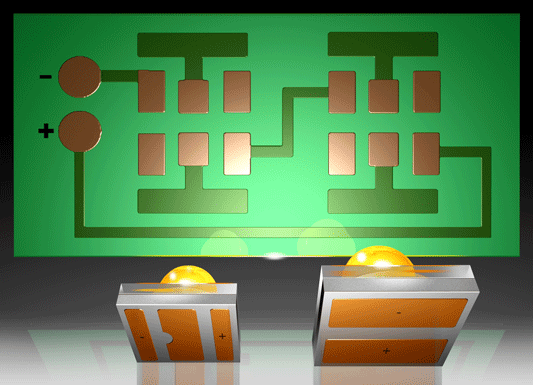- News
19 July 2012
Osram offers uniform solder pad design based on Oslon LEDs to enable second sourcing
Since not all LEDs are the same (regarding not only their performance and dimensions but also their solder pads and processing options), Osram Opto Semiconductors GmbH of Regensburg, Germany has developed a concept for uniform solder pads based on its Oslon LED family that makes it easier to use LEDs from different (second source) manufacturers and reduces the costs of storage and process modification.

Picture: Adapted solder pad design enables two different LED types to be accommodated on one board.
Second sourcing is a standard practice for LED components because of the need for security of supply, says Osram Opto. Ideally, it should be possible to incorporate second-sourced products into current production without incurring additional costs. However, components from different manufacturers generally differ in terms of their dimensions and shape of their solder pads. As a result, typically two different soldering boards are needed for LEDs from two different manufacturers, driving up costs for procuring and storing the boards and also for modifying the process to fit each board.
Osram Opto has developed a concept for ceramic LED components, such as the Oslon family, that makes the board solder pad design so adaptable that it can be used for LED components from at least two different manufacturers. The concept can also be used for metal core, FR4 and ceramic boards.
“Only a small adjustment to the process is needed, and the benefits are real and long-term,” says Dr Christian Gartner, Oslon project manager in Product Development General Lighting. The combined board design comes from the design of one of the two LED components. The individual solder surfaces are divided into segments – electrically connected and electrically disconnected. By selecting appropriate spacings between the solder surfaces, the second LED product – rotated by 90° – can be attached to the uniform board design. The anode and cathode of the two LED components are connected to the same electrically contacted segments. By dividing the solder surfaces, the two LED types automatically align themselves to the edges of the solder surfaces during the reflow solder process. For both LED components, the luminous area is in the same lateral position on the board – i.e. in the same alignment in the board plane. If the LEDs have the same emission behavior, the same secondary lenses and reflectors can be used. So, neither the LED components nor the end application are changed in terms of their characteristics.
Osram Opto says that the new concept makes it much easier to handle LED components from different manufacturers because there is no longer the need to make modifications to the board design. Also, there is no need for duplicated storage, reducing costs still further. “The concept for a flexible solder pad design gives our customers the freedom to incorporate a second source for our high-power LED components without having to suffer restrictions due to mechanical parameters,” summarizes Gartner.
